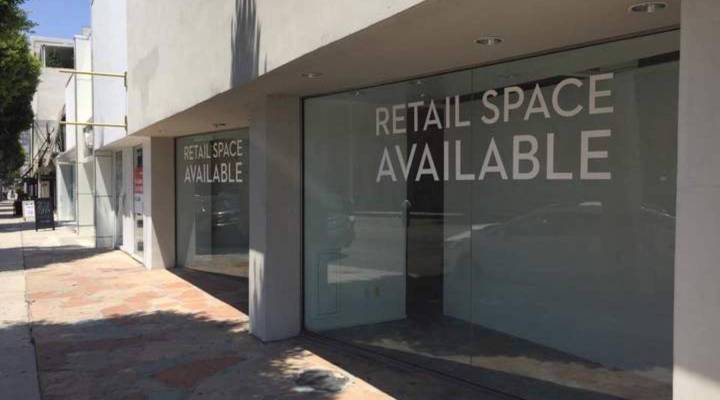
A retail story: How LA’s Robertson Boulevard went from paparazzi heaven to vacant stores
A retail story: How LA’s Robertson Boulevard went from paparazzi heaven to vacant stores

There are hardly any shoppers on Robertson Boulevard on a recent visit, compared to the throngs on nearby Rodeo Drive or Melrose Avenue. Robertson is a bit of a contradiction. While there is a Chanel store selling $3,000 handbags, it’s surrounded by depressing vacant storefronts.
There are a few tourists on the street, here mostly for one reason.
“Pretty much The Ivy,” said Samantha Young, from Arizona. “We’re visiting. We know about The Ivy, and we really wanted to go.”
She’s talking about the white picket-fenced restaurant that’s been a landmark here for decades. She’s surprised by what she sees on the rest of the street.
“Especially being as busy an area as it is, it’s very noticeable when it’s vacant like this,” Young said.
About a third of the retail spaces on Robertson are vacant, a far cry from when Fraser Ross opened kitschy high-end retailer Kitson here in 2000. The store became the epicenter of LA fame culture.
“The heyday was probably 2005, when the reality stars would come to Robertson to be photographed,” Ross said. “And even the A-list actors would go to The Ivy and have lunch.”
Lindsay Lohan famously crashed her car on Robertson after one such lunch. Crowds would gather here just to watch Paris Hilton shop. The street was full of trendy boutiques back then. But Ross said that changed beginning in 2008 — just before the recession.
| All the stores you shopped at as a teen are going bankrupt |
| On Fifth Avenue, vacancy rates spike along with rents |
| Brick and mortar stores are dying, but not at this mall |
“Big chains came to Robertson,” Ross said. “Ralph Lauren came. Chanel. I think they came to Robertson to try to get that hip type of credibility to their brand.”
Dolce & Gabbana. Lululemon. Michael Kors. Tommy Hilfiger. These brands all set up shop on Robertson, and rents skyrocketed.
“Robertson rents got up to Rodeo Drive numbers in 2008,” said real estate broker Jay Luchs at Newmark Knight Frank.
Stores that rented for $3 per square foot per month in the late ’90s were going for around $30. Landlords dug in their heels when the recession hit, forcing some indie retailers off the street.
That’s as the hype around Robertson was fading. Even Kitson left the street a couple of years ago when the brand folded.
With the surge of online shopping, justifying vanity storefronts became harder for the big brands. Most left Robertson and haven’t all been replaced. Ralph Lauren’s 11,000-square-foot boutique, opened in 2008, has been empty for two years.
The sky-high rents demanded by landlords have had to be rethought.
“These are landlords that will admit to your face that they were wrong,” said Luchs, whose name you’ll see printed on ‘For Lease’ signs up and down Robertson Boulevard.
Now landlords are advertising space not for $30 but for $10, and Luchs said some are making deals for under $5.
“Other landlords don’t have that ability because they paid up for it, and they’re waiting out for rents to come back up,” Luchs said. “I don’t think they’ll go back to what they were.”
With some landlords offering cheap rents, the street is attracting new stores and could be headed toward a renaissance. Peri Arenas opened new boutique Peri.A on the street in April.
“I used to come to Los Angeles a lot many years ago, and I used to love Robertson when it was happening. The fact that it’s quiet now only made me want to come back and make it happen again.”
Arenas is excited that a new restaurant, coffee shop and boxing gym are coming to the street soon — things you can’t do online.

Kitson founder Fraser Ross opened Kitross last year in the same Robertson Boulevard where his original store opened in 2000.
Fraser Ross is back on Robertson, too. He opened a new store called Kitross last year in the same space Kitson used to be. It’s retooled for the Instagram era, with luxury swan and flamingo pool floats inflated on the sidewalk to draw people in. He’s also hung vinyl signs on the windows of the vacant building next to his.
“I did it because I didn’t want to look at an empty storefront anymore,” Ross said. “It says ‘I Heart LA,’ so at least people stand by here and take pictures.”
Ross said he got his rent way down, but with so many retailers still jumping ship, he’s not sure it’s low enough. That’s the challenge for anyone considering filling space on the street.
“You don’t know what’s going to happen on the street five years from now,” Ross said. “If it’s going to be worse, better, or if no one will buy retail brick and mortar, they’ll only buy on Amazon.”
There’s a lot happening in the world. Through it all, Marketplace is here for you.
You rely on Marketplace to break down the world’s events and tell you how it affects you in a fact-based, approachable way. We rely on your financial support to keep making that possible.
Your donation today powers the independent journalism that you rely on. For just $5/month, you can help sustain Marketplace so we can keep reporting on the things that matter to you.


















